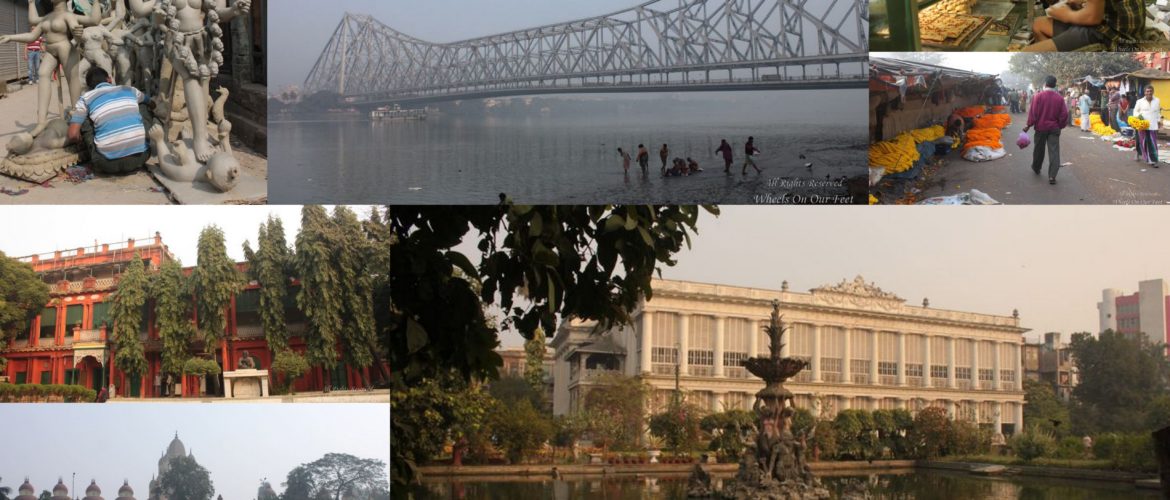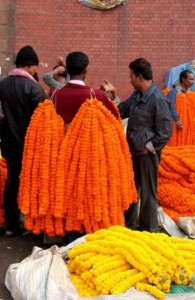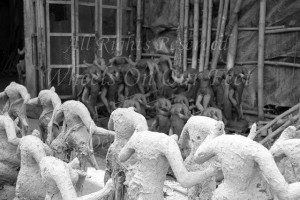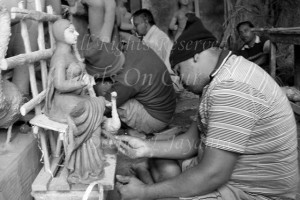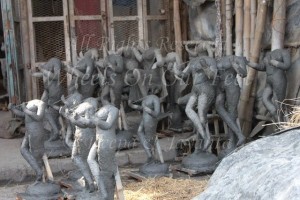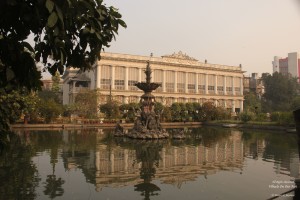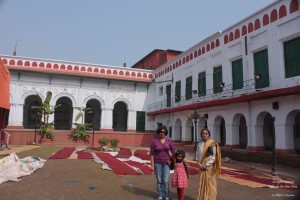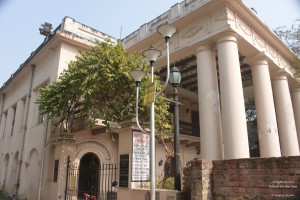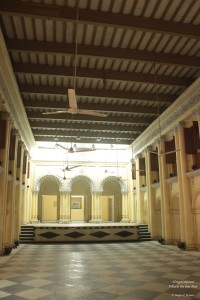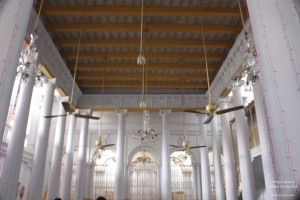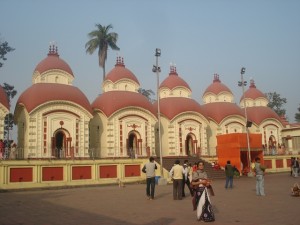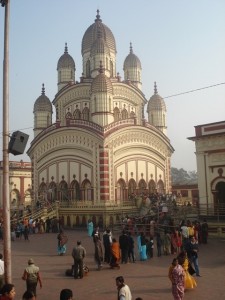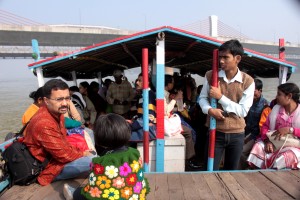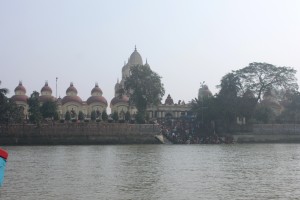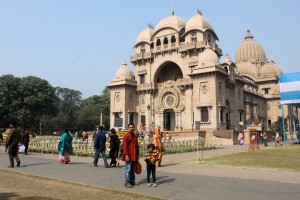Times, how they change. Or, maybe, how we change over time. As kids, during our Kolkata vacations, we hated the sight of the dilapidated buildings of Bara Bazar, the narrow and ever-crowded streets of Shyam Bazar and accused Kolkata of never changing. And now, after decades, one look at the same state of these very streets and their buildings, we thank the heavens for not letting ‘re-development’ not touching them. Yet. For, these very streets, tell the tale of a very very rich Kolkata – rich in its culture, taste, literature, pursuit of excellence. Take a few days in your hands, a few leisurely days mind you, and set out every day to explore the age-old streets, buildings, shops….unravel their stories…strike up conversations with elderly locals to speaks of yesteryears…
Tour of Howrah Bridge, Mallick Ghat, Flower Market with pit stop at Deshbandhu Mistan for breakfast
Perhaps you could start with a walk across the iconic Howrah Bridge one morning. We did that and loved every bit of it. Key is to reach the train station end very early in the morning, so that you can beat the crowd, the cars and the insane honking. Walk across the bridge, savour the moments, and once on the other side, turn right towards Mallick Ghat for a beautiful view of the river and the bridge. The walk to Mallick Ghat will take you past Kolkata’s wholesale flower market – a delightfully alive place with heaps and heaps of flowers being traded for the day. Wrap your morning with a sinful breakfast of deep-fried puris with potato curry, and Bengali mishit at Deshbandhu Mistan.
- Walking across Howrah Bridge
- View of the Howrah Bridge from Mallick Ghat
- Deshbandhu Mistan for breakfast
- Flower Market near Mallick Ghat
Tour of Kumortuli, Marble Palace, Shovabazar Rajbari, ChatuBabu LattuBabu Bari, Jorashankho with a pit stop at Girish Nakur for their famous Sandesh
Kumortuli is Kolkata’s famous lanes of ‘God makers’. Yes, this is where potters make idols of gods and goddesses for the city’s numerous festivals, and even send them out to other cities and countries. Be amazed at their deftness, their exquisite skills in almost putting life into these idols…Kumortuli is located in North Kolkata, very close to Shobha Bazaar. There are no taxi-drivers or bus-drivers in Kolkata who do not know this famous place. You simply have to utter the name Kumortuli and just about anybody will guide you to the right street. In case you plan to take the metro, alight at the Shobha Bazaar metro station, walk out and ask for directions. It is walking distance. Upon enquiry, the Kumors told us that during Durga Puja, photography enthusiasts and visitors are allowed entry only via passes, in order to sanitise the crowd. During the rest of the year, you can walk into Kumortuli anytime. Walk down the lanes at a leisurely pace, strike a conversation with the Kumors and you will go back home/hotel richer with anecdotes and stories.
- Kumortuli
- Kumortuli
- Kumortuli
Next, set out for the Marble place. This stumps you completely! One moment you will be meandering through extremely narrow lanes around the Shobha Bazaar area, and the next moment you will see this majestic palace with extremely lavish lawns!! And the first thought that will strike you is, “How?” You then find out that the Marble Palace was built in the first half of the 19th Century by a rich merchant, is filled with artifacts and sculptures from all around the world and is still owned by descendants of the family who debar you from taking any photographs of the inside of the mansion.
One of North Kolkata’s most popular destinations, Shobhabazar Rajbari is also famous for its annual Durga Puja celebrations. If you happen to go there during any other time of the year, as we did, you will have to contend with its towering columns and imposing courtyard. And some pieces of its history that proves its allegiance to the British rule, and it being one of the important seats of Bengal’s renaissance. The Rajbari also has a Nat Mandir adjacent to it.
- Shobhabazar Rajbari
- Nat Mandir of Shobhabazar Rajbari
- Nat Mandir of Shobhabazar Rajbari
Another of those Bonedi, meaning heritage, homes of Noth Kolkata, the ChatuBabu LattuBabu house and its mandir belonged to one of Kolkata’s richest businessmen, Ram Dulal Babu. In modest condition presently, the house is still known for the Durga Puja it celebrates every October.
Next, ask a local to show you the way to Girish and Nakur, a 100-year old shop that sells the most delectable Sandeshes in the world at rates that can blow your mind, if the Sandesh haven’t already!! Have your fill and then buy some more for the rest of the day….
Time now to go and see the house of the most famous Bengali in the world – Rabindranath Tagore’s Jorashanko. The greater part of the house has been transformed into a museum – you will see here the room where Rabindranath Tagore was born, the room where he stayed, his set of pen, paint brushes, stories about him and his times, and more. We loitered around a long time, both in the museum and the enclosed courtyard, being completely numbed by the thought of walking the same grounds the Bard had once walked, touching the same walls He had once touched. And wished we could come over during the many festivals that Rabindra Bharati University observes here…..
Tour of Dakhineshwar Temple and Belur Math, with pit stop at the stalls at Dakhineshwar for their Kachoris and Mishti
Dakhineshwar temple is revered by millions and is always thronging with devotees coming from far and wide, who normally take a dip in the banks of the Hoogly flowing by the temple premises, and then queue up to offer their prayers to Goddess Kali. Believers feel strongly about invoking Goddess Kali’s blessings for important occasions/landmarks, starting of newer projects, thanksgiving here. Saint Ramakrishna Paramhansa attained his sainthood in this temple. Dakhineshwar was also where Swami Vivekananda turned to when he renounced worldly cares. Go there whether for prayers or just a traveller’s curiosity. Once again, early mornings are best. Stop by at the stalls outside the temple for breakfast. They sell kachuri-cholar dal, shingara, Bengali mishit and tea in earthen cups. But remember, hygiene is completely side-lined here. So gorge at your own peril
- Premises of the Dakhineshwar Temple
- Dakhineshwar Temple
For those who don’t know, Belur Math is famous for being the headquarters of Ramakrishna Mission, a spiritual and charitable organisation well-known for its secular teachings and inclusive social-development programs for the poor. Located just across the Hoogly river from Dakhineshwar Temple, Belur Math draws followers from every religion. Sparse, clean and full of trees and seasonal flowers, the Math is for those who come to seek God in silence. Take a ferry across the river from Dakhineshwar temple.
- Ferry from Dakhineshwar Temple to Belur Math
- Belur Math
- Beur Math

